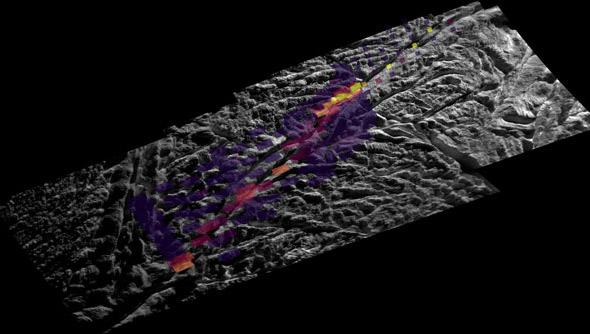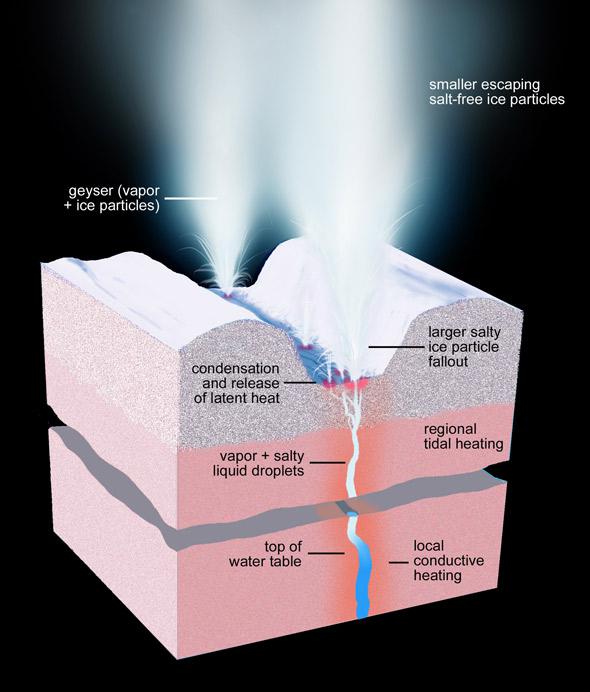In the outer solar system, a moon of Saturn is erupting. Enceladus, a ball of ice 500 kilometers across, has more than 100 geysers erupting near its south pole, and they’re blasting nearly a thousand tons of water into the sky every hour. After six years of observations using the Cassini spacecraft, astronomers are finally starting to get a handle on what’s causing this massive outbreak. They’ve also found clues that liquid water is making it from deep inside the moon all the way to the surface.
A little background: The geysers were discovered when Cassini took backlit images of Enceladus; that is, when the Sun was behind the moon. The surface of the moon was dark, so longer exposures were taken. A faint fan of light was seen coming from the moon’s south pole, and it was quickly discovered that it was in fact due to gigantic plumes from water geysers reaching hundreds of kilometers high.
After they were discovered, Cassini’s orbit was altered so it would pass the little moon many times. At one point the spacecraft actually flew right through the plumes, and it was able to sample the constituents. It found they were mostly made of water ice, but there was also the presence of salt and organic compounds. Not life, of course, but an intriguing list of ingredients that contained some of the needed elements for biology.
The questions remained: What is causing these geysers? Where is the water coming from? And there’s more: Hot spots (well, warmer than the surrounding ice, but still well below the freezing point of water) were seen using thermal imaging, and they lined up with the geysers. Were they causing the geysers, or were the geysers heating up the ice around them?

Photo by NASA/JPL/Space Science Institute
Two new papers have just been released that are the culmination of all those years of work: The geysers—101 in total—are powered by the mighty gravity of Saturn, they are the source of the heat (and not vice versa), and the water does appear to be coming from deep within the moon. Here’s how that all works.
The strength of gravity drops with distance. That means the side of Enceladus facing Saturn is tugged a bit harder than the far side. This results in a stretching force, called the tidal force. Moreover, Enceladus doesn’t orbit Saturn in a perfect circle. Sometimes it’s a bit closer, sometimes a bit farther. The orbit is also tilted a wee bit, so different parts of the moon experience different tides from Saturn.
This constantly changing stress has created deep cracks near the south pole of Enceladus. Called sulci, there are four of them, roughly parallel, stretching across the terrain. (They’ve been nicknamed “tiger stripes.”) The tides from Saturn’s gravity opens and closes these cracks as the moon orbits around the planet. The geysers are erupting from these cracks, as you can see in this nifty 3-D video created using Cassini data:
Cassini observations have shown definitively that the plumes wax and wane in strength at different parts of the orbit, so they are certainly caused by tides. However, oddly, there’s a 5.7 hour delay in the maximum brightness in the geyser plumes versus what you’d expect from where the moon is in its orbit. While tides are driving this phenomenon, the delay means there’s something else going on as well. It’s not clear what it is, which means there’s more yet to understand here.
Cassini has a high-resolution thermal camera on board, too. It found hot spots corresponding to the geyser locations all along the tiger stripes. It was proposed that these may have been due to friction; literally the edges of the cracks rubbing together as the moon flexed over its orbit. If true, that meant the hot spots may have been causing the geysers.
However, that turns out not to be the case. The sharp images of the hot spots show them to be very small, just a few tens of meters across, roughly the size of a tennis court. That’s too small to be explained by frictional heating. So what’s causing them?

Diagram by NASA/JPL/Space Science Institute
It turns out to be the geysers themselves! The diagram above shows what’s going on. Deep under the surface of Enceladus is a vast repository of water (possibly a global ocean, or it may just be local lakes under the pole). Tidal flexing keeps the water liquid, and at the times in the orbit when the cracks open, the water can travel up the cracks. Under pressure, it erupts at the surface, blasting out the plume. As it does, it cools, releasing its internal heat. That warms the surface, creating the hot spots.
This is actually pretty amazing. It means that the geysers are occurring near the surface, but begin their journey much farther down. It also means that water from deep underneath the surface is mixing with the ice on top, and temporarily creating liquid water at the surface—the only other place in the solar system where that’s known to happen.
As Cassini imaging team leader Carolyn Porco points out, there are about 1,000 geysers on Earth, which means that about 10 percent of all the known geysers in the solar system are on Enceladus. That’s a nifty factoid for your next cocktail party.
As I said, there’s still many unknowns here, and the data are still coming in. Unfortunately, time is running out for Cassini: The mission is scheduled to end in 2017. I’m of two minds about that; I know that funds are limited, and the mission began in earnest when Cassini entered orbit around Saturn in 2004. That’s a long time for a planetary mission to go! On the other hand—and this is a much bigger hand—Cassini is doing phenomenal work. Much of what it’s discovered has been because it’s been in orbit so long. It’s had a long baseline to observe and has seen amazing events that a shorter mission would have missed entirely.
Extending Cassini’s life would be a great idea, obviously, if NASA had the funding. That’s a rant I’ve made many times before, but Cassini is grand evidence supporting it. The longer we stay at Saturn, the more we learn about this ridiculously fascinating world and its fleet of moons. And that’s exactly what we should be doing.
